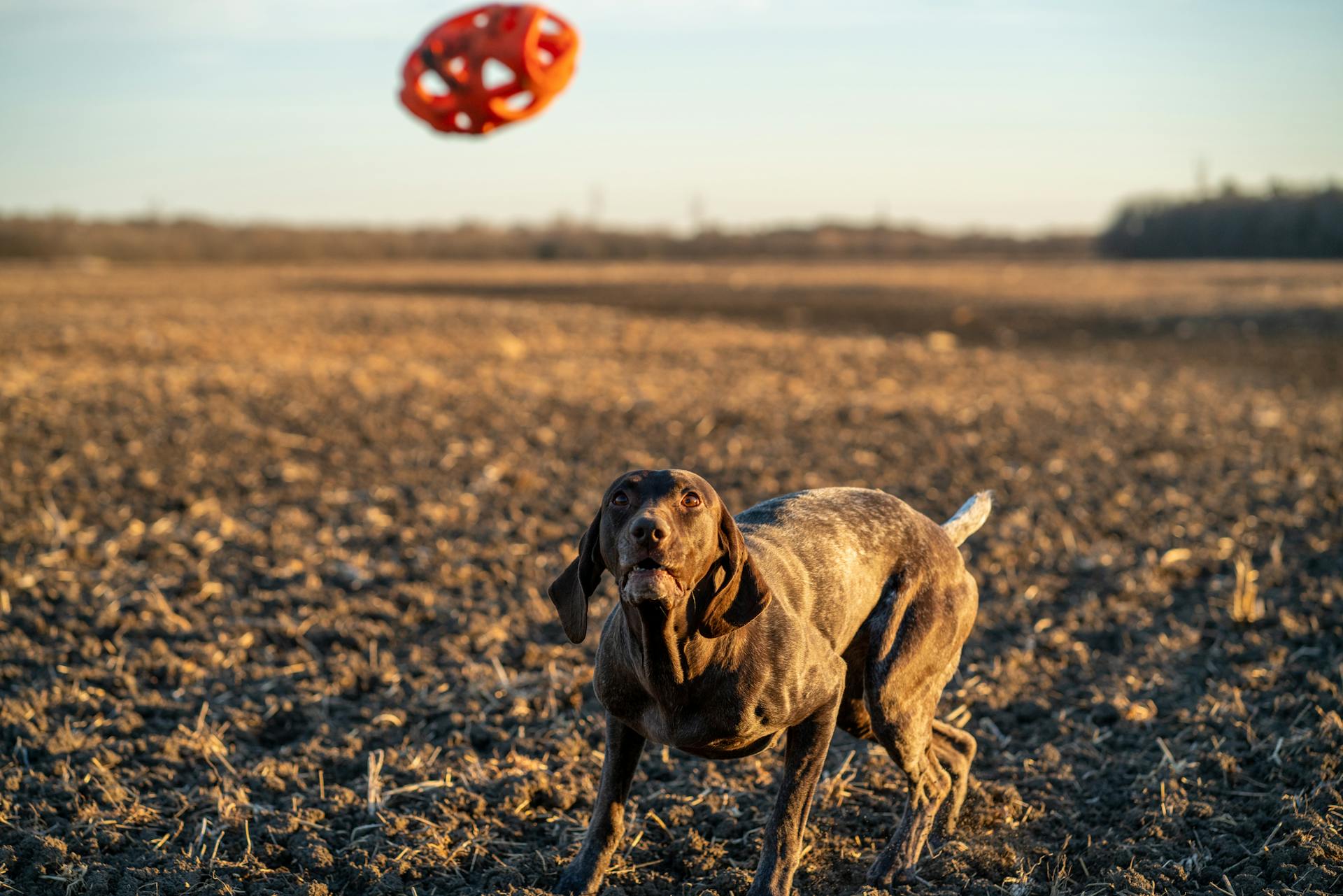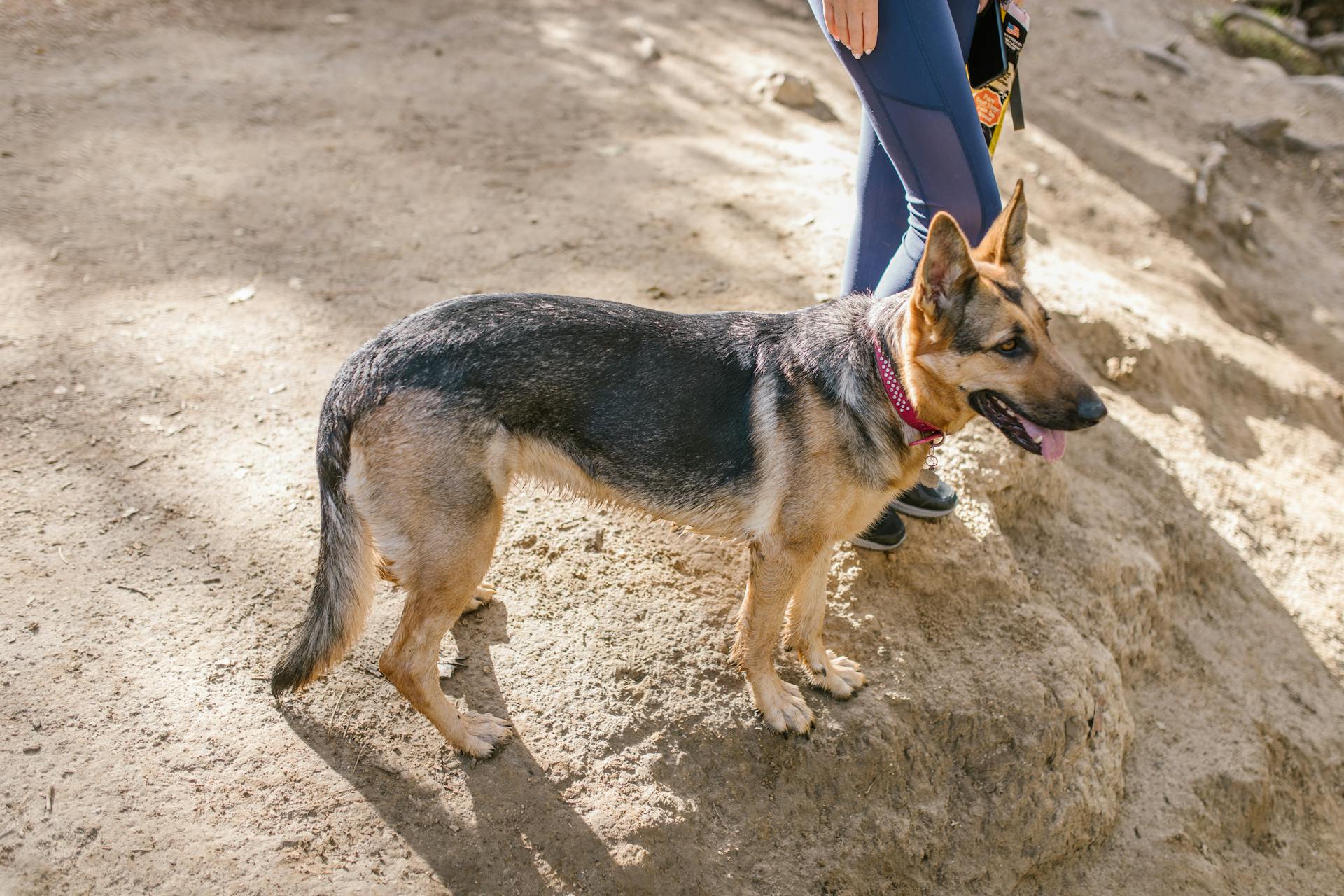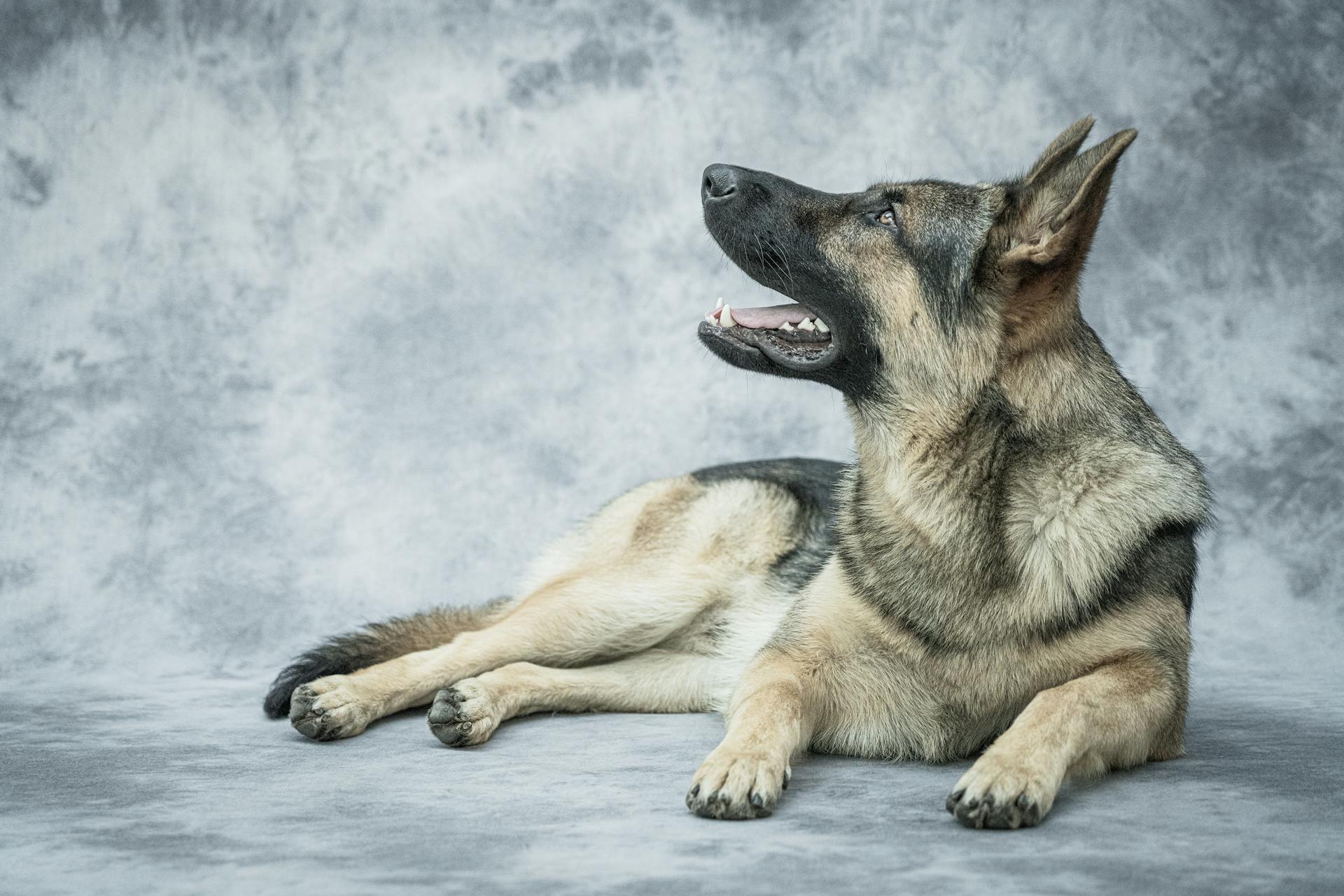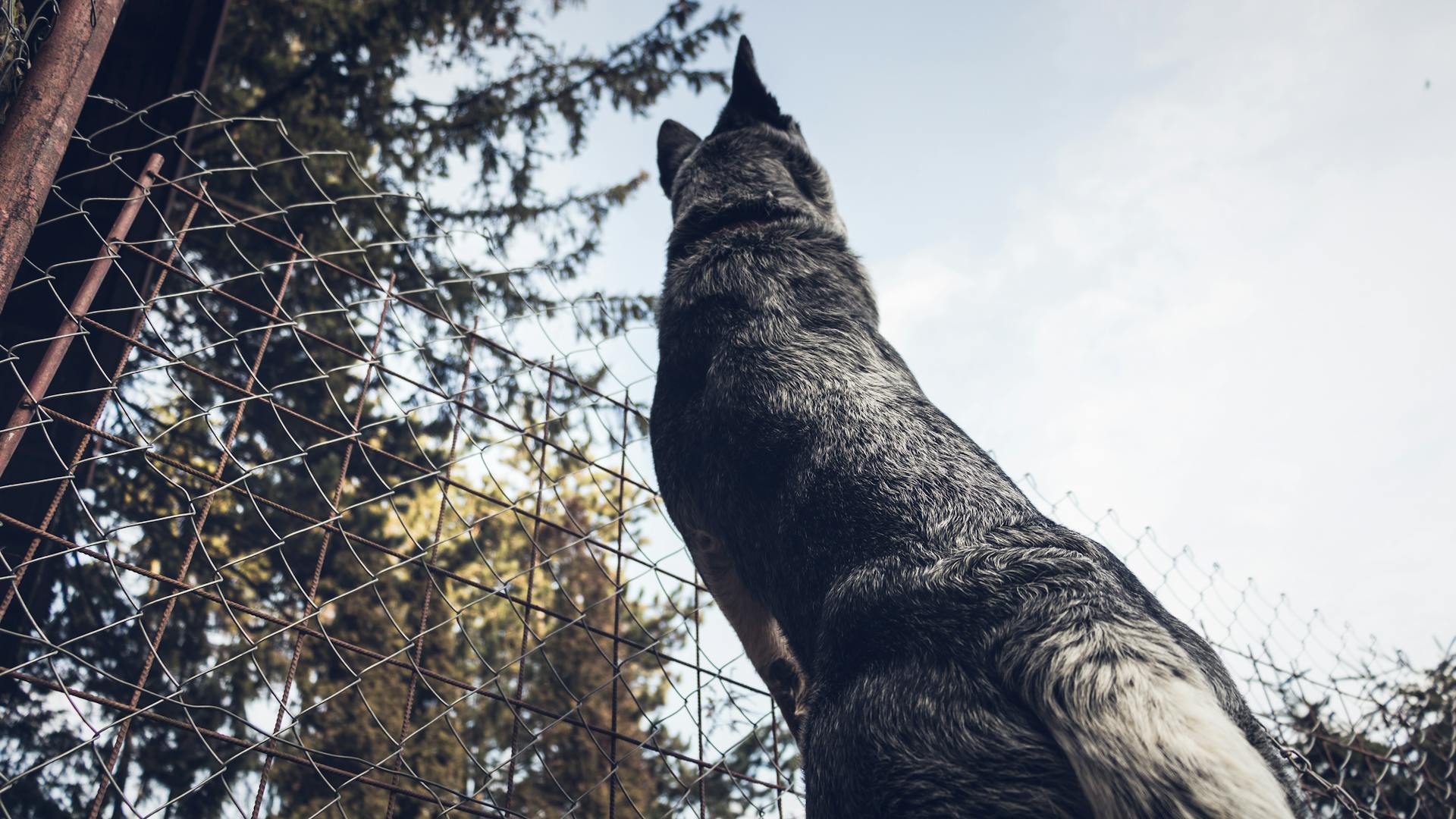
The German Shorthaired Pointer is a versatile and energetic breed that originated in Germany in the 19th century.
They were bred to be hunting companions, exceling at retrieving game such as birds and small mammals.
Their short coat requires minimal grooming, making them a great choice for busy owners.
German Shorthaired Pointers are highly intelligent and trainable, but can be strong-willed at times.
History
The breed's early development involved combining German bird dogs and Spanish pointers, which likely resulted in the versatile and intelligent gundog we know today. By the 1800s, the breed had already gained popularity among hunters and field trailers.
In 1878, the Verein zur Veredelung der Hunderassen in Frankfurt am Main held a dog show where breed standards for German dogs were established. This marked the beginning of the breed's formal recognition.
Spanish Pointer Connection
The Old Spanish Pointer is the ancestor of all pointing dog breeds in Europe, including the German breeds we're going to explore.
This ancient breed spread throughout France and the Low Countries, eventually reaching the German-speaking world where it was used in bird-hunting with falcons and later with guns.
In the 1700s and 1800s, German breeders combined the Old Spanish Pointer with other breeds to create a versatile hunting dog, a process that took generations.
The resulting breed, known as the Deutsch Kurzhaar, was officially recognized by the Fédération Cynologique Internationale in 1954.
A combination of German bird dogs and Spanish pointers is likely behind the creation of the German Shorthaired Pointer (GSP), according to the GSPCA.
The GSP was recognized by the American Kennel Club in 1930, and its ancestors were used for bird-hunting with nets or falcons in the German-speaking world.
This early connection to the Spanish Pointer is still evident in the GSP's keen sense of smell and ability to retrieve waterfowl.
Arkwright Connection
The Arkwright Connection is a fascinating topic in the history of the German Shorthaired Pointer. The breed is often credited with bringing in a high nose, a solid point, and a black coat, thanks to the influence of the Arkwright Pointer.

William Arkwright never referred to his dogs as "Arkwright Pointers", but rather as English Pointers with black coats. They had been around for a long time before he began to breed them, and he considered them to be among the purest strains.
The term "Arkwright Pointer" only appears in histories of the GSP, and not in histories of the English Pointer. It's likely that the Germans used this term to avoid using the term "English Pointer", which might have been considered impolite during a time of tension between the two countries.
The use of the term "Arkwright Pointer" is reminiscent of the time when the German Shepherd Dog was referred to as the "Alsatian" in the US and UK, likely due to anti-German sentiment.
See what others are reading: Best Time to Breed Dog in Heat
Characteristics
The German Shorthaired Pointer is a medium-sized dog, standing between 62-66 cm at the withers. Bitches are slightly smaller, about 3 or 4 cm less.
The coat is a key characteristic of this breed, being dense, short, and rough-textured. It can be either brown or black, with various patterns including solid-coloured, white, and roan.
The head of a German Shorthaired Pointer is moderate in size, with a convex profile and a long, broad, and strong muzzle. The eyes are brown, the ears are rounded and set high, and hang close to the head.
Here are some common characteristics of the German Shorthaired Pointer:
Pointer Overview
The German Shorthaired Pointer is a versatile breed that excels in various roles, from family pet to hunting companion.
Their medium size, ranging from 26-60 pounds, makes them a great fit for families with children, as they are generally gentle and patient.
With a short coat that requires minimal grooming, they are a low-maintenance addition to any household.
They come in a variety of colors, including brown, chocolate, and liver, with patterns such as flecked, ticked, or speckled.
Their high intelligence makes them relatively easy to train, but be prepared for their strong willfulness.
A table highlighting some key characteristics of the German Shorthaired Pointer:
Their high energy level and love of water make them an excellent choice for families who enjoy outdoor activities.
Appearance
German Shorthaired Pointers are a medium-to-large breed with a regal stance. They stand between 21-25 inches tall and weigh between 45-70 pounds.
Their nose is a large, brown oval that adds to their distinctive look. Females tend to be slightly smaller than males.
The breed's coat is dense and short, with a rough texture that's easy to maintain. They shed moderately, requiring more frequent brushing during shedding seasons.
Their ears are floppy and rounded, while their eyes are dark and almond-shaped. The breed's unique markings and color combinations set them apart from other breeds.
You'll never find a black nose on a liver-colored dog, as the nose always matches the color of the coat.
Broaden your view: English Mastiff Large
Temperament
German shorthaired pointers are smart dogs, willing to please, and easy to get along with. They have lots of energy to burn and will let you know when they're feeling playful.
Their high prey drive is a result of their hunting history, which means they're wired to chase any small animal that crosses their path. This is why a fenced yard and leashed walks are a must for this free-spirited breed.
Explore further: Dogs Breeds That Start with B
GSPs are quick to learn with a little patience and positive reinforcement. They're kid-friendly and kind, getting along with other dogs and being polite with most strangers.
If you're considering getting a GSP, it's essential to remember that they hate being bored. They thrive on having a job to do and need plenty of exercise, games, interactive toys, and puzzle feeders to keep their minds occupied.
Here are some key temperament traits to keep in mind:
- High energy level: 21 to 25 inches tall and 45 to 70 pounds
- Playful and outgoing: friendly, outgoing, playful, willful
- Good with children: kid-friendly and kind, but may be a little rambunctious
- Strong loyalty tendencies: prone to following their instincts and may wander off
Their love for water and hot weather tolerance make them great hiking companions, but they do require regular grooming and may be prone to health issues.
Good Swimmers
German Shorthaired Pointers are very good swimmers thanks to their webbed feet and sleek, muscular build.
They love spending time in the water, but you should be cautious in winter as their shorter hair can make them prone to getting too cold, even in water that's suitable for longer-haired dogs like Labradors.
Versatile Hunting Dogs
The German Shorthaired Pointer is a true hunting machine, bred to excel in a variety of roles.
They can work in all types of weather and terrain, making them a versatile hunting companion.
Their instinctive nature allows them to hunt, point, and retrieve a wide range of game, including rabbits, raccoons, game birds, and even deer.
Whether you're hunting in the field or competing in dog sports, the German Shorthaired Pointer is a natural performer.
They're equally at home in water and on land, able to retrieve game with ease.
With their high energy levels, they need plenty of exercise and mental stimulation to keep them happy and healthy.
German Shorthaired Pointers are also used in law enforcement for tasks like nosework, showing their intelligence and versatility.
You might like: Game Bred American Pit Bull Terrier
Frequently Asked Questions
What two dogs make a GSP?
The German Shorthaired Pointer (GSP) was developed by crossing the Spanish Pointer with the Hanoverian Hound. This unique blend of breeds created an all-purpose hunting dog.
What are the weaknesses of German shorthaired pointers?
German Shorthaired Pointers are prone to hip dysplasia, eye problems, and arthritis, which can impact their health and quality of life. Regular veterinary care and genetic testing can help identify these issues early on.
What is the leading cause of death in German shorthaired pointers?
The leading cause of death in German shorthaired pointers is cancer, with a notable risk of breast cancer in females. Spaying early can significantly reduce this risk.
Why are GSPs so fast?
The German Shorthaired Pointer's streamlined body design allows for exceptional speed and agility, making them well-suited for hunting. Their balanced and symmetrical physique enables them to move quickly and efficiently.
Sources
- https://projectupland.com/hunting-dogs/german-shorthaired-pointer-origins-and-traits/
- https://www.akc.org/dog-breeds/german-shorthaired-pointer/
- https://en.wikipedia.org/wiki/German_Shorthaired_Pointer
- https://www.dailypaws.com/dogs-puppies/dog-breeds/german-shorthaired-pointer
- https://www.akc.org/expert-advice/lifestyle/german-shorthaired-pointer-fun-facts/
Featured Images: pexels.com


